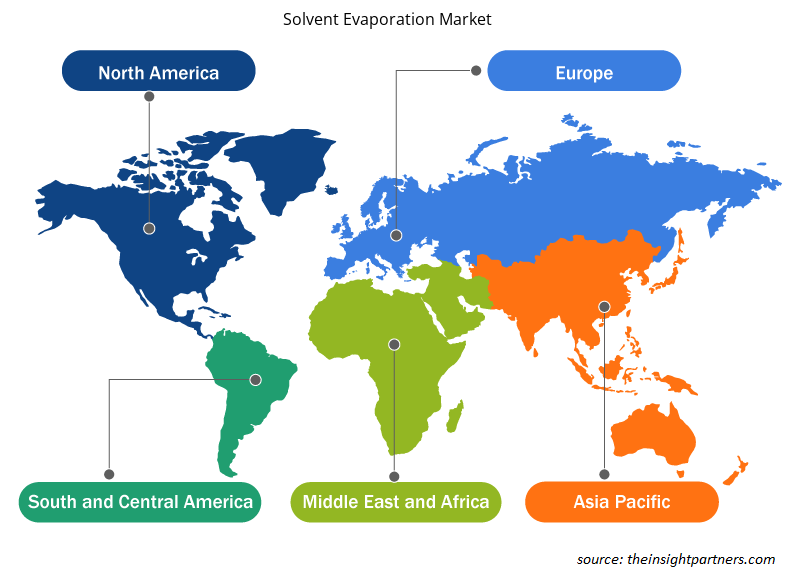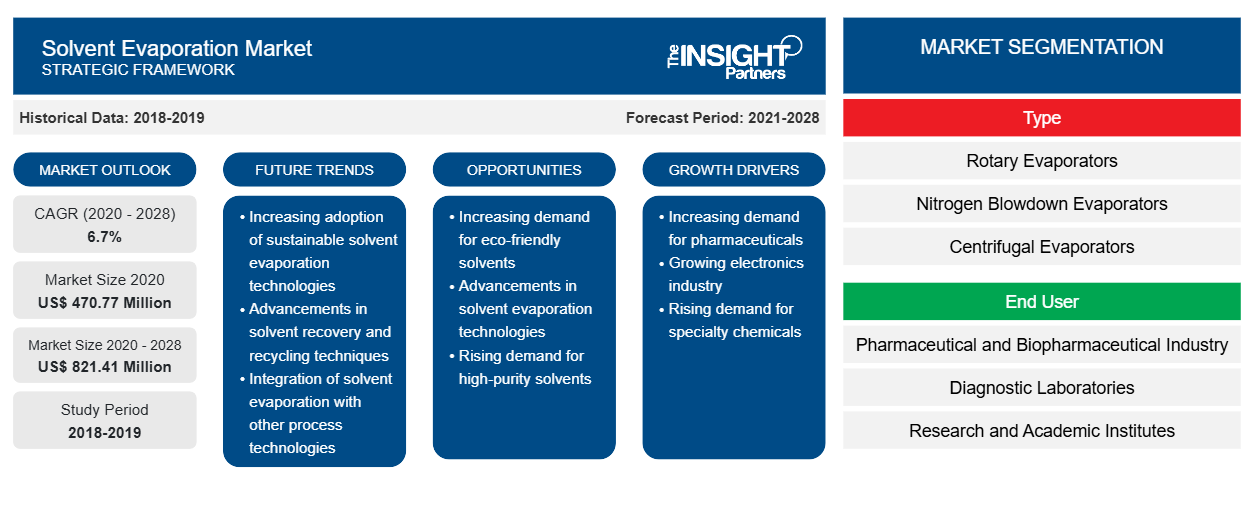El mercado de evaporación de solventes se valoró en US$ 470,77 millones en 2020 y se proyecta que alcance los US$ 821,41 millones para 2028; se espera que crezca a una CAGR del 6,7% durante 2021-2028.
La evaporación de disolventes implica la emulsión de polímeros en fase acuosa y su dispersión en un disolvente volátil como diclorometano, cloroformo y acetato de etilo. A continuación, el disolvente se evapora utilizando alta temperatura, vacío o agitación continua. El tamaño de las partículas se puede controlar ajustando parámetros como manipulando la temperatura de evaporación, controlando la velocidad de evaporación, manipulando la velocidad de agitación, etc. Este método se está practicando para las nanopartículas desarrolladas utilizando polímeros respectivos como PLA, PLGA, PCL, polihidroxibutirato, etc. cargados con varios fármacos como toxoide tetánico, testosterona, loperamida, ciclosporina A e indometacina. Los evaporadores de disolventes se utilizan ampliamente en procesos como la microencapsulación y son necesarios para preparar nanopartículas poliméricas para varias formulaciones farmacéuticas. Los avances tecnológicos en los sistemas de evaporación de disolventes, como la concentración centrífuga, la liofilización y las trampas de frío de alta potencia, han llevado a una evaporación mejorada y una mejor recuperación de disolventes, con un menor impacto ambiental.
Factores como el aumento del gasto en I+D, el creciente desarrollo de productos biofarmacéuticos de moléculas grandes y la creciente demanda de muestras puras en los mercados de uso final impulsan el crecimiento del mercado de evaporación de disolventes. Sin embargo, las imprecisiones en los resultados y el desperdicio de recursos debido a la inquietud asociada con la evaporación de disolventes obstaculizan el crecimiento del mercado de evaporación de disolventes .
Personalice este informe según sus necesidades
Obtendrá personalización en cualquier informe, sin cargo, incluidas partes de este informe o análisis a nivel de país, paquete de datos de Excel, así como también grandes ofertas y descuentos para empresas emergentes y universidades.
-
Obtenga las principales tendencias clave del mercado de este informe.Esta muestra GRATUITA incluirá análisis de datos, desde tendencias del mercado hasta estimaciones y pronósticos.
Perspectivas del mercado
Aumento del gasto en I+D en la industria farmacéutica
Las sustancias activas de evaporación de disolventes son un paso esencial en el proceso de descubrimiento de fármacos, ya que se utilizan en etapas como la síntesis, la preparación de muestras y el reciclaje de disolventes, así como en la ampliación de la producción de nuevas terapias. Muchas empresas farmacéuticas invierten enormes cantidades en procesos de investigación y desarrollo (I+D) que giran principalmente en torno al descubrimiento y desarrollo de moléculas innovadoras. Según un informe publicado en Statista, el gasto mundial en I+D farmacéutica ascendió a unos 181.000 millones de dólares en 2018, y se espera que alcance los 223.000 millones de dólares en 2026. Según la India Brand Equity Foundation, las empresas farmacéuticas indias invirtieron aproximadamente el 7,0% de sus ingresos en el proceso de I+D en 2015 y la inversión en I+D creció un 8,6% en 2019. Por tanto, el aumento del gasto en I+D está impulsando el crecimiento del mercado de evaporación de disolventes.
Perspectivas basadas en tipos
Según el tipo, el mercado de evaporación de disolventes se segmenta en evaporadores rotativos, evaporadores con purga de nitrógeno, evaporadores centrífugos y evaporadores de flujo de aire en espiral. El segmento de evaporadores rotativos tuvo la mayor participación del mercado en 2020. Sin embargo, se estima que el segmento de evaporadores con purga de nitrógeno registrará la CAGR más alta del mercado del 7,4% durante el período de pronóstico. El evaporador rotativo juega un papel importante en la extracción eficiente de disolventes a través de la evaporación, lo que es un paso importante en el desarrollo de muestras puras en varias industrias. Los factores como el aumento de los gastos de I+D y varios beneficios asociados con esta técnica están impulsando el crecimiento del mercado de evaporación de disolventes.
Información basada en el usuario final
Según el usuario final, el mercado de evaporación de disolventes se segmenta en la industria farmacéutica y biofarmacéutica, los laboratorios de diagnóstico y los institutos de investigación y académicos. El segmento de la industria farmacéutica y biofarmacéutica tuvo la mayor participación del mercado en 2020. Sin embargo, se estima que el segmento de institutos de investigación y académicos registrará la CAGR más alta del mercado del 7,7 % durante el período de pronóstico, debido a factores como el aumento de los estudios de desarrollo de fármacos y la creciente demanda de innovación continua y mejora de los productos existentes.
Varias empresas que operan en el mercado de evaporación de solventes utilizan estrategias como lanzamientos de productos, fusiones y adquisiciones, colaboraciones, innovaciones de productos y expansiones de carteras de productos para expandir su presencia en todo el mundo, mantener la marca y satisfacer la creciente demanda de los usuarios finales.
Perspectivas regionales del mercado de evaporación de disolventes
Los analistas de Insight Partners explicaron en detalle las tendencias y los factores regionales que influyen en el mercado de evaporación de solventes durante el período de pronóstico. Esta sección también analiza los segmentos y la geografía del mercado de evaporación de solventes en América del Norte, Europa, Asia Pacífico, Medio Oriente y África, y América del Sur y Central.

- Obtenga datos regionales específicos para el mercado de evaporación de solventes
Alcance del informe de mercado sobre evaporación de disolventes
| Atributo del informe | Detalles |
|---|---|
| Tamaño del mercado en 2020 | US$ 470,77 millones |
| Tamaño del mercado en 2028 | US$ 821,41 millones |
| Tasa de crecimiento anual compuesta (CAGR) global (2020-2028) | 6,7% |
| Datos históricos | 2018-2019 |
| Período de pronóstico | 2021-2028 |
| Segmentos cubiertos |
Por tipo
|
| Regiones y países cubiertos |
América del norte
|
| Líderes del mercado y perfiles de empresas clave |
|
Densidad de los actores del mercado de evaporación de disolventes: comprensión de su impacto en la dinámica empresarial
El mercado de evaporación de solventes está creciendo rápidamente, impulsado por la creciente demanda de los usuarios finales debido a factores como la evolución de las preferencias de los consumidores, los avances tecnológicos y una mayor conciencia de los beneficios del producto. A medida que aumenta la demanda, las empresas amplían sus ofertas, innovan para satisfacer las necesidades de los consumidores y aprovechan las tendencias emergentes, lo que impulsa aún más el crecimiento del mercado.
La densidad de actores del mercado se refiere a la distribución de las empresas o firmas que operan dentro de un mercado o industria en particular. Indica cuántos competidores (actores del mercado) están presentes en un espacio de mercado determinado en relación con su tamaño o valor total de mercado.
Las principales empresas que operan en el mercado de evaporación de disolventes son:
- BUCHI LABORTECHNIK AG
- BIOTAGE AB
- CORPORACIÓN LABCONCO
- INSTRUMENTOS HEIDOLPH GMBH & CO. KG
- Compañía científica Yamato, Ltd.
Descargo de responsabilidad : Las empresas enumeradas anteriormente no están clasificadas en ningún orden particular.

- Obtenga una descripción general de los principales actores clave del mercado de evaporación de solventes
Mercado de evaporación de disolventes por tipo
- Evaporadores rotativos
- Evaporadores de purga de nitrógeno
- Evaporadores centrífugos
- Evaporadores de flujo de aire en espiral
Mercado de evaporación de disolventes: por usuario final
- Industria farmacéutica y biofarmacéutica
- Laboratorios de diagnóstico
- Institutos de investigación y académicos
Mercado de evaporación de disolventes por geografía
-
América del norte
- A NOSOTROS
- Canadá
- México
-
Europa
- Francia
- Alemania
- Italia
- Reino Unido
- España
- Resto de Europa
-
Asia Pacífico (APAC)
- Porcelana
- India
- Corea del Sur
- Japón
- Australia
- Resto de Asia Pacífico
-
Oriente Medio y África (MEA)
- Sudáfrica
- Arabia Saudita
- Emiratos Árabes Unidos
- Resto de Oriente Medio y África
-
América del Sur (SAM)
- Brasil
- Argentina
- Resto de América del Sur y Central
Perfiles de empresas
- BUCHI LABORTECHNIK AG
- BIOTAGE AB
- CORPORACIÓN LABCONCO
- INSTRUMENTOS HEIDOLPH GMBH & CO. KG
- Compañía científica Yamato, Ltd.
- PLC PORVAIR
- IKA WERKE GMBH Y CO. KG
- ESTEROGLASS SRL
- ASOCIADOS DE ORGANOMACIÓN, INC.
- KNF NEUBERGER, INC.
- Raykol
- DISEÑOS DE ALBARICOQUE, INC.
- LABTECH SRL
- MEDIA LUNA CIENTÍFICA
- Compañía SCINCO, LTD.
- Análisis histórico (2 años), año base, pronóstico (7 años) con CAGR
- Análisis PEST y FODA
- Tamaño del mercado, valor/volumen: global, regional y nacional
- Industria y panorama competitivo
- Conjunto de datos de Excel
Informes recientes
Testimonios
Razón para comprar
- Toma de decisiones informada
- Comprensión de la dinámica del mercado
- Análisis competitivo
- Información sobre clientes
- Pronósticos del mercado
- Mitigación de riesgos
- Planificación estratégica
- Justificación de la inversión
- Identificación de mercados emergentes
- Mejora de las estrategias de marketing
- Impulso de la eficiencia operativa
- Alineación con las tendencias regulatorias























 Obtenga una muestra gratuita para - Mercado de evaporación de disolventes
Obtenga una muestra gratuita para - Mercado de evaporación de disolventes